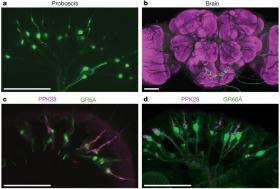April 8, 2010 report
How fruit flies taste water

(PhysOrg.com) -- The ability to detect water and regulate water intake is essential for all animals because if cells have too little or too much water the consequences for the animal can be disastrous. It is unclear whether humans and other animals actually taste the water or just impurities within it, but studies have shown that insects can taste water.
It has been known, for example, that the fruit fly (Drosophila) can taste water, but until now none of the molecular details of how the detection is achieved have been known. Now, scientists have discovered how the nerve cells in the feeding tube of Drosophila sense water and transit the information to the brain. This may lead to other discoveries about how cells sense and control their water content.
The scientists found a newly discovered protein called PPK28 forms a channel spanning the membrane of a water-sensing nerve cell in Drosophila’s feeding tube. It is one of a family of ion channel proteins, but none of these proteins had previously been thought to be involved in regulating water flow.
The research aiming to identify the water taste receptor in Drosophila was carried out by student Peter Cameron as a PhD thesis project, under the guidance of Kristin Scott, Professor of Genetics at the University of California, Berkeley. The researchers compared normal fruit flies to a mutant group lacking the channel. They showed the mutant flies with no active taste neurons drank for only around three seconds, while normal flies drank for about 10 seconds. Cameron and colleagues then compared the genes of the two fly groups and identified a gene called pickpocket 28 (ppk28) that expresses the protein PPK28 in the taste neurons. They then marked the protein with a fluorescent tag and compared its responses to various solutions. When the flies were given water, the protein lit up, indicating it was sending a signal to their brains.
The researchers found that when the ppk28 gene was missing, the flies did not respond to water, but when it was present they did. They also discovered the neurons responded more to plain water than to solutions containing salts, acids, sugars, or bitter compounds. When Cameron activated ppk28 genes in nerves usually involved in sensing bitterness, the nerves began to respond to water. Cameron said PPK28 is the only known water taste receptor ever found in Drosophila, but it is possible that other mechanisms may be at work.
Cameron said the results may provide a framework for investigating water taste in other animals. The findings are reported in the journal Nature.
More information: The molecular basis for water taste in Drosophila, Nature advance online publication 4 April 2010, doi:10.1038/nature09011
© 2010 PhysOrg.com















